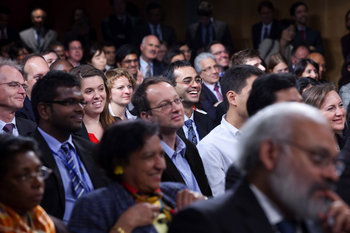
Organizational Structure
High power distance is associated with hierarchical organizations with a strict command and control structure. Low power distance tends to lead to flatter organizations with authority distributed to many individuals.Decision Making
High power distance is associated with concentrated decision making whereby leaders don't ask for the opinions of subordinates and subordinates rarely challenge leadership decisions.Communication
In a low power distance setting, leaders carefully communicate their plans to seek acceptance and engagement from the group. People feel relatively free to challenge the strategy and ideas of leadership. In a high power distance setting, it may be unthinkable to challenge a superior.Independence
People at the bottom of a low power distance organization or society have relative independence from their leaders. For example, knowledge workers who have significant freedom to practice their profession as they see fit as long as they achieve a set of objectives. In a high power distance setting, people at the bottom are carefully controlled and monitored.Ambiguity
Where power distance is high, people may expect leaders to provide specific direction and become upset when faced with significant ambiguity.Merit
Low power distance requires individuals to justify a superior position with their merit. Competition may be intense with everyone believing they can lead. If power distance is extremely low not even merit may be enough to justify more power with power distributed evenly in the name of equalness regardless of incompetence. In a high power distance setting, power may be easily distributed to friends, family and allies without much of a challenge.Accountability
Low power distance demands accountability of leaders. High power distance may result in a lack of accountability such that ethical lapses go unpunished.Charity
In a high power distance country, those who need help from society may be viewed as weak and lazy while the elite view themselves as superior and worthy of luxuries. As such, high power distance may lead to a lack of charity and social infrastructure.Classes
Generally speaking, low power distance is associated with a large middle class whereby many people are at a similar level of society. High power distance is associated with a large gap between the poor and the wealthy with little in between.Paternalism
High power distance may result in a paternalistic society whereby governments and/or firms regular and control many aspects of life in the "best interests" of the individual. This comes with the implicit assumption that people are unable to act in their own best interests and those of their family.Notes
Malaysia, the Philippines, Indonesia, Russia and China are examples of high power distance countries with scores between 80 and 100.New Zealand, Denmark, Norway, United Kingdom and Germany have low power distance scores between 18 and 35.The United States, Canada and Japan have somewhat low power distance scores between 39 and 54.| Overview: Power Distance | ||
Type | ||
Definition | The degree to which a society accepts that power is distributed unequally. | |
Related Concepts | ||




























